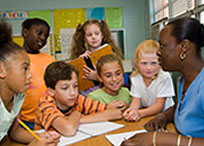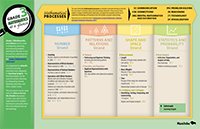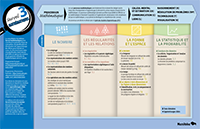
GRADE 3: MATHEMATICS
What your child is learning
There are four areas, or “strands,” in Grade 3 math:
Inside the Number strand, children
- count forward and backward from 0 to 1000 by 5s, 10s, 25s and 100s;
- use objects, pictures and numbers to show and compare quantities up to 1000;
- count forward and backward from 0 to 100 by 3s and 4s;
- add and subtract to 1000 and recall addition and subtraction facts to 18;
- understand multiplication up to 5 X 5 and related division;
- show the meaning of place value for numbers up to 1000;
- understand fractions as a part of a whole.
In the Patterns and Relationships strand, children
- create increasing and decreasing patterns using objects, pictures and numbers up to 1000;
- solve equations such as “93 plus what equals 107?”.
In the Shape and Space strand, children
- measure time, mass, length and perimeter;
- describe 3-D objects and sort shapes by number of sides.
In the Statistic and Probability strand, children collect and organize information using charts, lists and graphs to solve problems.
In order to achieve lifelong learning in mathematics, children:
- communicate what they are thinking and learning;
- connect math to everyday situations and other subjects;
- estimate and use mental math strategies;
- learn through problem solving;
- reason and explain their thinking;
- use technology to enhance their learning;
- use visual images (think in pictures) to describe their thinking.
To find out more about what your child is learning, we encourage you to talk to the teacher. You may also find helpful information on the Curriculum Essentials posters, which are interactive PDFs designed for teachers that provide an overview of the knowledge, processes, and skills for this subject area.
The first page gives an overview of what your child will be learning, grouped into learning targets (concepts) so that the curriculum is easier to understand. The number codes correspond to the curriculum learning outcomes. The arrow at the top of the page highlights the mathematical processes, which are described in more detail on the third page. These are the ways through which mathematical concepts are taught. The second page offers a more detailed description of the expectations related to each concept and the categories found on the provincial report cards regarding assessment.
You may also wish to refer to the Mathematics - Manitoba Curriculum Framework of Outcomes.
How your child is assessed
There are two types of assessment in Grade 3 Math: teacher’s classroom assessments and the Grade 3 Provincial Assessment (![]() 1.77 MB).
1.77 MB).
Using a variety of tools and strategies, the teacher assesses the students on the four math strands. Student’s learning is assessed through the three categories on the report card: knowledge and understanding, mental math and estimation, and problem solving. The teacher reports on the student progress on these categories three times a year. Each report gives you an opportunity to discuss results, strengths, challenges and next steps with your child and your child’s teacher, to help you support your child’s learning.
The Grade 3 Provincial Assessment looks at reading and numeracy. The numeracy assessment takes place in the fall over a period of weeks during which teachers gain a sense of each student’s strengths and weaknesses. It is used as a tool for classroom planning. The assessment looks at number skills including adding and subtracting, using the equal sign and working with patterns. Your child needs these skills throughout their school years and beyond.
Your Child and the Grade 3 and Grade 4 Provincial Assessment (![]() 1.77 MB)
1.77 MB)
Resources
Helping Your Child Learn Math: A Parent’s Guide
This guide offers suggestions of hands-on activities that promote problem solving, communication, and links to daily life to help develop your child's math skills and understanding.
Early Years Mathematics Activities and Games
These games and activities, presented in MS Word and Adobe PDF files, can be used at home.
Numeracy At Home Newsletters
Each newsletter offers a variety of interesting and challenging activities to support student thinking and learning of mathematics.
Glossary
Frequently Asked Questions
Here are some questions that are often asked about mathematics:
If you have a question that isn't answered here, you can ask your child's teacher or use the comment form on the left of the page.
What has changed in the new curriculum? |
How can I stay informed about the revised mathematics program? |
Will my child learn basic addition, subtraction and multiplication? |
What do you mean by mental math and estimation? |
What are mental math strategies? |
How can I help my child with mental math and estimation? |
What is meant by personal strategies? |
What is meant by problem solving? |



 490 KB)
490 KB)

